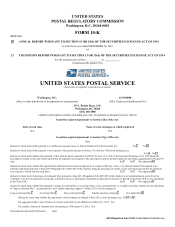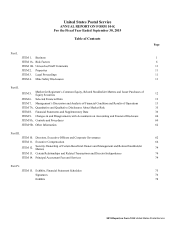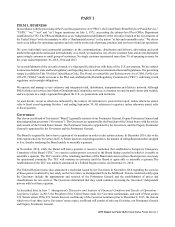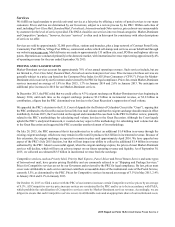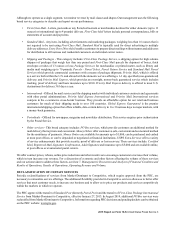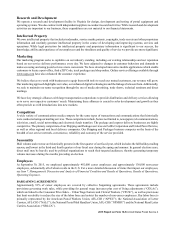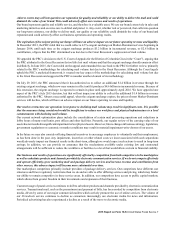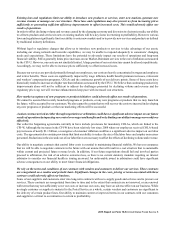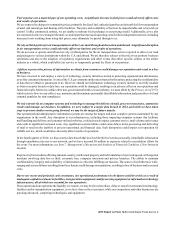US Postal Service 2015 Annual Report Download - page 10
Download and view the complete annual report
Please find page 10 of the 2015 US Postal Service annual report below. You can navigate through the pages in the report by either clicking on the pages listed below, or by using the keyword search tool below to find specific information within the annual report.2015 Report on Form 10-K United States Postal Service 8
Existing laws and regulations limit our ability to introduce new products or services, enter new markets, generate new
revenue streams or manage our cost structure. These laws and regulations may also prevent us from increasing prices
sufficiently or generating sufficient efficiency improvements to offset increased costs. This would adversely affect our
results of operations.
In order to offset declining volume and revenue caused by the changing economy and diversion to electronic media, our ability
to sell new products and services in new or existing markets will be a key factor in returning to profitability. However, various
laws and regulations significantly limit our ability to enter new markets and/or to provide new services and products as defined
by traditional industry definitions.
Without legal or regulatory changes that allow us to introduce new products or services to take advantage of our assets,
including our strong network and last-mile capabilities, we may be unable to respond adequately to consumers’ changing
needs and expectations. These limitations have the potential to adversely impact our results of operations and long-term
financial viability. PAEA generally limits price increases on our Market-Dominant services to the rate of inflation as measured
by the CPI-U. However, our costs are not similarly limited. A large portion of our cost structure cannot be altered expeditiously.
Accordingly, we may not be able to increase prices sufficiently to offset increased costs.
Because our services are provided primarily through our employees, our costs are heavily concentrated in wages and employee
and retiree benefits. These costs are significantly impacted by wage inflation, health benefit premium increases, retirement
and workers’ compensation programs, COLAs and the continuous growth of our delivery points. Some of these costs have
historically tended to increase at a higher rate than inflation as measured by the CPI-U. We believe that continuing productivity
improvements alone will not be sufficient to address the challenges presented by declining volume and revenue and the
regulatory price cap, nor will revenue enhancements keep pace with increased cost structures.
Slow market acceptance of new programs or product initiatives could adversely affect our results of operations.
We cannot be assured that recently launched programs or products, or any new programs or products that we may launch in
the future, will be accepted by our customers. We also cannot be certain that we will recover the costs we incurred in developing
any new programs or products or that our marketing efforts will be successful.
A union contract arrived at either through negotiation or arbitration could have a significant adverse impact on our future
results of operations by impacting our control over wages and benefits and/or by limiting our ability to manage our workforce
effectively.
Our collective bargaining agreements currently in force include provisions for mandatory COLAs, which are linked to the
CPI-W. Although the increases in the CPI-W have been relatively low since 2008 when our employees received COLA-based
pay increases of nearly $1.1 billion, a resurgence of consumer inflation could have a significant adverse impact on our labor
costs. The agreements also contain provisions that limit our ability to reduce the size of the labor force and employ non-career
personnel. Reductions in the size and cost of our labor force are necessary to offset the effects of declining volume and revenue.
Our ability to negotiate contracts that control labor costs is essential to maintaining financial stability. We have no assurance
that we will be able to negotiate contracts in the future with our unions that will result in a cost structure that is sustainable
within current and projected future revenue levels. In addition, if our future negotiations should fail and involved parties
proceed to arbitration, the risk of an adverse outcome rises, as there is no current statutory mandate requiring an interest
arbitrator to consider our financial health in issuing an award. An unfavorable award in arbitration could have significant
adverse consequences on our ability to meet future financial obligations.
We rely on the terms and conditions of our contracts with vendors and customers to deliver our services. These contracts
are renegotiated on a routine and periodic basis. Significant changes in the costs, pricing or terms associated with these
contracts could adversely affect our business.
Some of our suppliers and customers enter into long-term contracts with us to supply goods and services and to procure our
services. These contracts are renegotiated from time to time and to the extent that contracts are not renewed, or are renewed
with terms that may not sufficiently cover our costs or increase our costs, may have an adverse effect on our business. While
no single customer or supplier is material to the Postal Service as a whole, certain vendors and customers are significant to
the delivery of certain product lines. Our ability to maintain current or improved terms in our contracts with our customers
and suppliers is critical to our initiatives to return to profitability.

